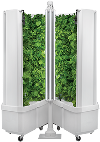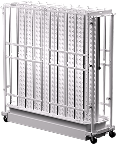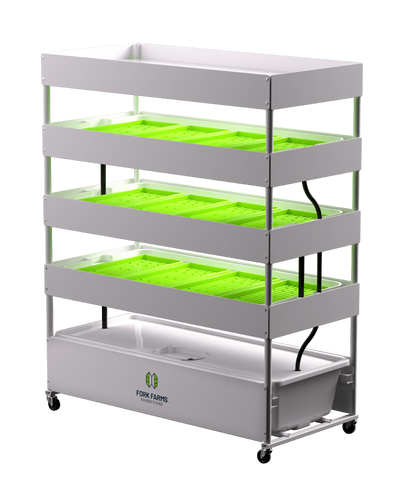How Much Food Can a Hydroponic Farm System Actually Grow?
Hydroponic systems offer a powerful and innovative approach to gardening. They provide a controlled environment for plant growth without the use of soil. Instead, crops are cultivated in a nutrient-rich water solution under conditions designed for optimal growth. These conditions include carefully monitored nutrient levels, pH balance, and water quality, as well as ideal lighting and proper ventilation to help plants thrive and produce abundant yields.
In fact, hydroponic farming often boasts higher crop yields compared to traditional soil-based farming thanks to its streamlined operation and better use of resources. But how much food can a hydroponic system actually grow? And how can growers get the most out of their soil-less gardens? As with so many things in life, the answers can be traced to a handful of key factors.
The Factors Influencing Yield With A Hydroponic System
By providing plants with precise amounts of nutrients and controlling environmental factors, hydroponic systems are designed for faster growth and increased productivity vs. traditional farming practices. These setups also allow for continuous planting without the need for a waiting period between crop cycles.
As noted previously, factors like light, temperature, and nutrient delivery play a big role in determining how much a hydroponic system can produce. In addition, taking into account things like the type of system you’re using and different crop varieties can provide further clarity on the amount of fresh food your hydroponic system is able to churn out. Let’s take a closer look.
The Types of Crops will Affect Yield
Choosing the right plant varieties can make a world of difference in your hydroponic system’s yield potential.
Leafy greens like lettuce (romaine, summer crisp, etc.) are some of the best and fastest growers around. Depending on the variety, you can expect an average of seven to eight harvests a year. If you harvest every 28 days you can even expect upwards of 13 harvests per year. Spinach, kale, and Swiss chard are also solid performers but may require some specialized care during germination.
A number of different herbs, including basil, parsley, and cilantro, can be grown easily with hydroponics as well. Much like leafy greens, they sprout up very quickly and can be harvested frequently.
Fruiting crops like tomatoes, cucumbers, and peppers can also be grown in hydroponic systems. Scaled-down versions like cherry tomatoes or mini-cucumbers tend to do well in hydroponic systems. It’s important to note that these crops will often have higher nutritional value than those bought at stores because hydroponic systems can eliminate long travel times and loss of nutrients found in produce bought through traditional means that take longer to get to one's plate.
While not all plants are suitable for hydroponics, several other types of fruits, vegetables, and herbs thrive in these gardens.
Nutrient Delivery In Hydroponic Systems
In hydroponic systems, plants grow without soil, receiving nutrients directly through the water. By providing the right balance of essential nutrients like nitrogen, phosphorus, and potassium, plants can thrive and produce bountiful harvests.
Nutrient management provides important macronutrients (fats, proteins, and carbs) and micronutrients (vitamins and minerals). It also involves fertilization, which rejuvenates and nourishes plants from root to tip.
Mastering fertilization techniques and schedules ensures that your plants are in peak condition and can be counted on to yield healthy–and healthy quantities of–produce.
Types of Hydroponic Farm Systems
Not all hydroponic setups are created equal. Whether it's a nutrient film technique (NFT), a drip system, an aeroponics system, or a deep water culture system, each approach has its advantages when it comes to food production. The size of your system also affects how much food you can grow.
In terms of spacing, hydroponics throws conventional gardening rules out the window. Most systems are designed so you can pack your plants closer together for peak efficiency, significantly boosting your garden's output.
Vertical farms like the Flex Farm have a modular design that allows farmers to maximize space and optimize ground use. By growing upwards instead of outwards, these units can produce three to ten times more crops in the same space as traditional farms. In fact, the Flex Farm can grow more than 394 pounds of leafy green produce annually, and that’s when you only have a single unit!
This particular design also makes it easier to isolate diseased plants and streamline the growth process.
Hydroponic Gardens Offer Environmental Control
Plants can be picky about their living conditions. But with proper lighting–including managing light-dark cycles–temperature, and humidity controls, your hydroponic setup can really produce results.
Choosing the right lighting systems and controlling the lights’ intensity helps mimic the natural sunlight that plants crave, further boosting their growth and yield potential.
Light inputs should also be optimized to ensure that plants receive the wavelengths that best support their growth. By targeting specific wavelengths, energy waste is minimized, and plants can absorb light more efficiently. The purple light typically used in hydroponic farms, for example, excludes wavelengths that plants don’t generally absorb very well.
As you might expect, water quality is equally critical. Keeping pH levels in check ensures that your hydroponic plants can digest their nutrients effectively and remain in good health. It’s worth noting, too, that most plants prefer slightly acidic conditions, so regularly testing and adjusting the pH of the nutrient solution is vital for maximizing production.
If You’re Looking For Results For Your Hydroponic Farm...
With the right setup and plants selected, hydroponic systems can produce abundant yields of leafy greens, herbs, and some fruiting crops. This allows fresh produce to be grown year-round in a small yet highly productive space.
And, since hydroponics does not require room for soil, crops can be grown in higher densities. This ability to maximize real estate further contributes to hydroponics’ increased crop yields for a given area. If we’re talking about raw figures, it’s not unreasonable to expect hydroponic systems to produce 20-30% higher yields than soil growing.
Scalable Solutions For Your Hydroponic Farm
Given all the options on the market, we believe the Flex Farm is the most efficient, scalable, and transformative indoor, vertical hydroponic technology available. Among its advantages, the Flex Farm uses the best components from different hydroponic systems, such as NFT and drip.
In terms of yield, the Flex Farm is capable of growing 25-plus lbs. of fresh food every 28 days; over the course of a year, growers can harvest up to 3,400 plants annually!
For larger-scale operations, the Flex Connect links multiple Flex Farms–anywhere from four to 12–up to a single water system. Its modular design allows you to expand crop production effortlessly, requiring minimal maintenance while offering streamlined energy use and nutrient delivery. Depending on your program needs, you can even scale up further by going with multiple Flex Connects!
The Flex Connect system comes with comprehensive support from the Fork Farms team, which offers a free Site Survey and Site Plan to make sure you’ve got the right setup for your program. You also get access to Fork Farms’ innovative Farmative community for large-scale growers, as well as enrollment in a special cultivation program for farmers with more than 12 Flex Farms.
Finally, if you’re considering an operation with 48 or more Flex Farms, there’s an innovative solution called the Flex Acre that’s been designed for schools, corporations, seasoned farmers, and nonfarmers alike. This system leverages groundbreaking technology that allows communities to grow a truly impressive amount of fresh fruits and vegetables in a remarkably small footprint: Standing 9 feet high, at 9 feet long and 3 feet wide, the Flex Acre is capable of producing 100-plus lbs. of food each month!
For expert advice on how to get started with a hydroponic system that all but guarantees a successful growing experience, connect with one of our Fork Farms team members today.























